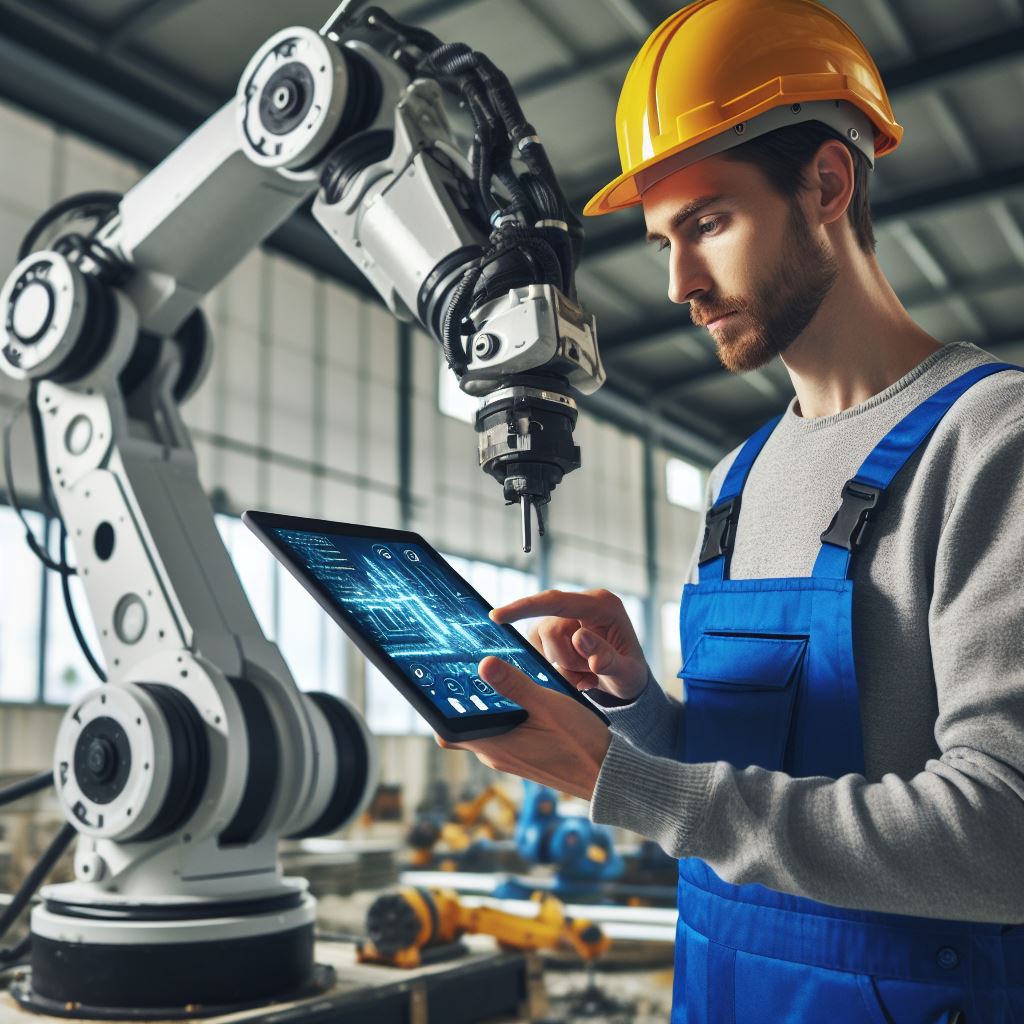Introduction
Technology has revolutionized various industries, including construction, transforming the way tasks are carried out.
Explanation of the topic and its relevance in today’s world
The impact of technology on construction jobs in the USA is a highly relevant and significant issue today.
Brief overview of the construction industry and its importance in the USA
The construction industry plays a vital role in the growth and development of the United States.
It encompasses infrastructure projects, residential and commercial buildings, and more.
With a sizeable workforce, it contributes to job creation and economic stability.
However, the industry has not been immune to the disruptive effects of technology.
In recent years, technological advancements have emerged, altering traditional construction methods.
These changes ensure increased efficiency, reduced costs, and improved safety measures.
One of the key areas where technology has made a significant impact is the adoption of Building Information Modeling (BIM).
BIM utilizes digital representations of buildings and infrastructure, enabling better collaboration and data management.
Furthermore, it allows for more precise planning, design visualization, and clash detection.
Robotics and automation have also redefined construction jobs.
Autonomous vehicles and drones are now used for site inspections and surveys.
Additionally, robots are employed for repetitive and physically demanding tasks, reducing the risk to human workers.
Furthermore, advancements in 3D printing have revolutionized construction practices.
This technology allows for the creation of intricate building components with utmost precision and efficiency.
It provides the opportunity to construct faster and with reduced material waste.
As technology progresses, there are concerns about job displacement.
Transform Your Career Today
Unlock a personalized career strategy that drives real results. Get tailored advice and a roadmap designed just for you.
Start NowWhile certain manual tasks may be automated, the need for skilled workers in operating and maintaining advanced machinery remains.
Moreover, technology has the potential to create new job roles in the construction industry, such as technicians specializing in robotics and AI.
Ultimately, the impact of technology on construction jobs in the USA is undeniable. It offers immense potential for increased productivity, cost-effectiveness, and improved safety.
To navigate this changing landscape, the industry and its workforce must adapt and embrace technological advancements.
Overview of Technology in Construction
Technology has revolutionized the construction industry, bringing in numerous advancements that have completely transformed the way construction jobs are performed in the USA.
From automated machinery to digital planning tools, technology is now an integral part of every construction project.
Explanation of Various Technological Advancements in the Construction Sector
- Building Information Modeling (BIM): BIM enables architects, engineers, and contractors to create a detailed virtual 3D model of a building, enabling better visualization and efficient collaboration among the team.
- Drones: Construction companies are increasingly using drones for aerial surveys, inspections, and monitoring construction progress, saving time and enhancing safety on site.
- Robotics: The use of robots in construction tasks such as bricklaying, welding, and demolition speeds up the process and reduces dependency on manual labor.
- 3D Printing: This revolutionary technology allows construction companies to create intricate structural components with precision, reducing waste and costs.
- Augmented Reality (AR): AR is being used for on-site visualization, helping workers overlay digital information on physical structures, enabling better decision-making and reducing errors.
- Internet of Things (IoT): IoT devices are used to monitor and control various construction processes, such as temperature, lighting, and security, improving efficiency and safety.
Examples of How Technology is Being Used in Construction Jobs
- Automation of Construction Equipment: Bulldozers, excavators, and cranes are now equipped with GPS and automation technology, enhancing accuracy and productivity.
- Prefabrication: With the help of technology, modular components can be precisely manufactured off-site and assembled on-site, reducing construction time and cost.
- Safety Enhancements: The use of wearable technology, such as smart helmets and vests, allows real-time monitoring of workers’ vital signs and alerting them of potential hazards.
- Advanced Project Management Software: Construction companies now use sophisticated software solutions to track project progress, manage resources, and communicate with stakeholders efficiently.
- Energy Efficiency: Technology has enabled the integration of sustainable systems like solar panels, energy-efficient HVAC systems, and smart lighting, reducing the environmental impact of buildings.
- Virtual Reality (VR) Training: VR simulators provide construction workers a realistic training environment, helping them learn skills and improve safety without exposing them to any real-life hazards.
The impact of technology on construction jobs in the USA has been profound, revolutionizing the industry from every aspect.
From improved efficiency and safety to reduced costs and environmental impact, technology has undoubtedly propelled the construction sector into a new era of progress and innovation.
As technology continues to evolve, it is crucial for construction professionals to stay updated with the latest advancements, embracing them to enhance their capabilities and deliver exceptional results in an ever-changing landscape.
Read: Apprenticeships: Your First Step in the Electric World
Positive impacts of technology on construction jobs
Technology has brought numerous benefits to the construction industry, transforming the way projects are executed and enhancing overall efficiency and safety.
Here are some of the positive impacts of technology on construction jobs:
Increased efficiency and productivity in construction processes
- Advanced construction software and tools have revolutionized project planning, scheduling, and monitoring.
- Automated machinery and equipment have expedited tasks that previously required extensive manual labor.
- Real-time collaboration platforms enable seamless communication and coordination among construction teams
Reduction in human errors due to technology-based tools and equipment
- Precision instruments and laser-guided systems have significantly improved accuracy in measuring and leveling.
- Computerized design software minimizes design flaws and enables architects to create intricate structures with ease.
- Drones equipped with sensors and cameras assist in conducting inspections and identifying potential issues
Enhanced safety measures in construction sites
- Virtual reality (VR) and augmented reality (AR) technologies allow workers to undergo safety training in simulated environments.
- Sensors embedded in personal protective equipment (PPE) monitor vital signs and alert workers and supervisors in case of emergencies.
- Smart wearables provide real-time feedback to workers, reminding them to maintain proper posture and avoid hazardous movements.
These positive impacts of technology have not only increased the efficiency and productivity of construction jobs but also played a crucial role in improving worker safety.
As technology continues to evolve, the construction industry can expect further advancements and benefits.
However, it is important to note that these benefits do not come without challenges.
The adoption of technology requires investment in training and upskilling the workforce to ensure effective utilization of new tools and systems.
Additionally, the initial cost of incorporating technology into construction processes may pose financial constraints for some firms.
Nevertheless, the long-term advantages outweigh these challenges.
The use of technology in construction jobs not only improves project outcomes but also attracts a broader talent pool to the industry.
The incorporation of advanced tools and equipment enhances job satisfaction for workers and increases their engagement in projects.
Transform Your Career Today
Unlock a personalized career strategy that drives real results. Get tailored advice and a roadmap designed just for you.
Start NowOn a final note, technology has had a significant positive impact on construction jobs in the USA.
Increased efficiency, reduced human errors, and enhanced safety measures have transformed the industry, making it more attractive and competitive.
By embracing technology and continuously adapting to new innovations, the construction industry can further improve its processes and create a safer and more efficient built environment for the future.
Read: The Role of Unions in the US Construction Worker’s Career
Negative impacts of technology on construction jobs
Potential job displacement due to automation and AI
- Automation and AI technologies can replace human labor, leading to potential job loss in the construction industry.
- Machines can perform tasks more quickly and efficiently, reducing the need for manual labor.
- Robots and drones can handle various construction tasks, including bricklaying and building inspections.
- As automation increases, there may be a decrease in the demand for traditional construction jobs.
Need for reskilling and upskilling to adapt to technological changes
- With the advancement of technology, construction workers need to acquire new skills to remain relevant.
- Traditional crafts such as carpentry may need to incorporate digital tools and techniques.
- Workers must learn to operate and maintain automated construction equipment.
- Proficiency in computer-aided design (CAD) and other software becomes necessary for construction professionals.
Challenges in maintaining the digital infrastructure
- Implementing and maintaining the necessary digital infrastructure can be challenging.
- Construction companies need to invest in reliable internet connectivity and technology infrastructure.
- Regular updates and maintenance of software and hardware systems require significant resources.
- Companies must ensure the compatibility and integration of different technological tools and platforms
In review, while technology brings numerous benefits to the construction industry, there are also negative impacts to consider.
The potential displacement of jobs due to automation and AI can be a concern for construction workers.
Therefore, reskilling and upskilling programs should be implemented to help workers adapt to technological changes.
In addition, companies face challenges in maintaining the digital infrastructure necessary for technology integration.
Overall, a careful balance needs to be maintained between technology adoption and ensuring employment opportunities in the construction sector.

Current Trends and Future Possibilities
Construction technology has witnessed significant advancements in recent years, transforming the way jobs are executed in the industry.
This blog section explores the latest trends in construction technology while delving into potential future advancements and their impact on jobs.
Latest Trends in Construction Technology
- Building Information Modeling (BIM) is revolutionizing the construction process by enhancing collaboration and efficiency.
- Robotics and automation have gained popularity, reducing manual labor and increasing productivity.
- Additive manufacturing, including 3D printing, is being utilized for rapid and cost-effective construction.
- Drones are being used for site surveys, inspections, and monitoring, providing real-time data.
- Smart construction materials, such as self-healing concrete and advanced insulation, are improving sustainability and durability.
- Virtual Reality (VR) and Augmented Reality (AR) are being implemented for enhanced visualization and training purposes.
These trends are transforming traditional construction methodologies, offering improved safety, precision, and efficiency.
However, their widespread adoption has raised concerns regarding potential job displacement.
Potential Future Advancements and Impact on Jobs
While the current trends in construction technology have already made an impact, there are several potential advancements that could shape the future of the industry.
Artificial Intelligence (AI)
AI can analyze vast amounts of data to optimize construction planning, scheduling, and resource allocation.
Although it may automate certain tasks, it would also create new job opportunities, particularly in AI development and maintenance.
Internet of Things (IoT)
IoT integration can enhance construction site safety by providing real-time monitoring of equipment, workers, and environmental conditions.
It can also improve maintenance processes, thus reducing downtime.
However, manual inspection jobs may decrease as IoT takes over.
Prefabrication and Modular Construction
Increased use of prefabrication and modular construction techniques will streamline the building process, reducing costs and time.
Transform Your Career Today
Unlock a personalized career strategy that drives real results. Get tailored advice and a roadmap designed just for you.
Start NowWhile this could reduce the need for some on-site labor, new job roles would emerge in designing, manufacturing, and assembling prefabricated components.
Robotics and Autonomous Construction Vehicles
Further advancements in robotics and autonomous construction vehicles can lead to a significant reduction in the need for manual labor.
However, robots will require skilled operators, technicians, and maintenance personnel, creating new job opportunities.
Sustainable Construction Solutions
As sustainability becomes a crucial focus, the development and implementation of eco-friendly construction solutions will increase.
This will lead to new job roles in green design, renewable energy integration, and energy-efficient building management systems.
While it is undeniable that technology is impacting the job landscape in the construction industry, it is important to note that advancements also bring forth new opportunities.
To adapt to the changing demands, workers should focus on upskilling and acquiring knowledge in emerging technologies.
This way, they can evolve alongside the industry and enhance their employability.
Overall, current trends in construction technology and potential future advancements have the potential to revolutionize the industry.
The key lies in striking a balance where technological advancements complement rather than replace human expertise, ultimately creating a more efficient and effective construction sector.
Read: Career Path: How to Become a Construction Worker in the US
Strategies for adapting to technological advancements
As technology continues to advance at a rapid pace, it is crucial for construction professionals in the USA to adapt and embrace these changes.
To stay relevant and competitive in the industry, here are some strategies for adapting to technological advancements:
- Stay updated on emerging technologies through continuous learning and professional development.
- Join industry associations and attend conferences and trade shows to stay informed about the latest trends.
- Invest in training programs and workshops to acquire the necessary skills and knowledge.
- Collaborate with technology experts and consultants to understand how new tools and systems can benefit construction projects.
- Embrace automation and robotics to improve efficiency and productivity in construction processes.
- Implement Building Information Modeling (BIM) software to streamline project management and reduce errors.
- Adopt mobile technology and cloud-based collaboration platforms for improved communication and remote project monitoring.
- Utilize drones and aerial mapping technologies for surveying, site inspections, and monitoring construction progress.
- Integrate augmented reality (AR) and virtual reality (VR) for enhanced visualization and design coordination.
- Explore the possibilities of 3D printing for creating complex architectural elements and prefabricated components.
Importance of embracing technology for construction professional
- Improved efficiency and productivity: Technology can automate mundane tasks, allowing professionals to focus on higher-value activities.
- Enhanced safety: Advanced monitoring systems and wearable technologies can help prevent accidents and promote a safer work environment.
- Cost savings: By adopting technology, construction professionals can reduce material waste, mitigate errors, and optimize resource allocation.
- Improved accuracy and quality: BIM and other software solutions enable precise project planning, reducing rework and enhancing construction quality.
- Increased competitiveness: Embracing technology can set construction professionals apart from competitors and attract new clients.
Suggestions for acquiring the necessary skills and knowledge
Enroll in specialized courses and certifications related to emerging technologies like BIM, drones, and AR/VR.
Participate in online forums and communities dedicated to technology in construction to learn from peers and experts.
Collaborate with educational institutions to establish partnerships and access training programs.
Seek mentorship or guidance from experienced professionals who have successfully integrated technology into their work.
Regularly engage in practical projects that involve using technology to gain hands-on experience.
Collaboration between the technology and construction industries
Develop strategic partnerships with technology companies to jointly develop and implement innovative solutions for the construction sector.
Encourage open dialogue and knowledge-sharing between technology experts and construction professionals.
Transform Your Career Today
Unlock a personalized career strategy that drives real results. Get tailored advice and a roadmap designed just for you.
Start NowForm innovation labs or consortiums to foster collaboration and experimentation with new technologies.
Advocate for policies and funding that support research and development in technology for the construction industry.
Participate in industry-wide initiatives and standards development to ensure compatibility and interoperability between different technological systems.
With the rapid advancement of technology, embracing and adapting to these changes is crucial for construction professionals in the USA.
By acquiring the necessary skills, collaborating with technology experts, and embracing innovative tools and systems, professionals can stay competitive and deliver better results in the ever-evolving construction industry.
Read: Earnings Insight: Construction Worker Salaries in the USA.
Conclusion
Technology has both positive and negative impacts on construction jobs in the USA.
On the positive side, it has improved efficiency and productivity, reduced labor costs, and enhanced safety in construction sites.
However, there are also negative aspects such as the potential loss of jobs and the need for reskilling and upskilling of workers.
Despite these challenges, embracing technology in the construction industry is crucial.
Construction companies should invest in training programs to empower their workforce with the necessary skills to adapt to the changing technological landscape.
Governments and educational institutions should also play a role in providing resources and support for workers to transition into tech-driven roles.
Additionally, the future of technology in the construction industry looks promising.
Advancements in robotics, automation, and artificial intelligence can revolutionize the construction process, streamlining tasks and creating new job opportunities.
While some jobs may become obsolete, new roles centered around technology implementation and maintenance will emerge.
To thrive in this ever-evolving industry, construction professionals should be willing to embrace technology and continuously upgrade their skills.
Adapting to change is essential, as those who resist may find themselves left behind.
By harnessing the power of technology and addressing its challenges head-on, the construction industry can not only enhance productivity but also create a more skilled and adaptable workforce.
Technology has forever altered the construction industry in the USA. While it poses challenges, embracing it is the way forward.
By doing so, we can unlock immense potential and shape a bright future for construction jobs.
Transform Your Career Today
Unlock a personalized career strategy that drives real results. Get tailored advice and a roadmap designed just for you.
Start Now[E-Books for Sale]
The Big Book of 500 High-Paying Jobs in America: Unlock Your Earning Potential
$19.99 • 500 High-Paying Jobs • 330 pages
Explore 500 high-paying jobs in America and learn how to boost your career, earn more, and achieve success!
See All 500 High-Paying Jobs of this E-Book
1001 Professions Without a Degree: High-Paying American Jobs You Can Start Now
$19.99 • 1001 Professions Without a Degree • 174 pages
Discover 1001 high-paying jobs without a degree! Unlock career tips, skills, and success strategies for just $19.99!




